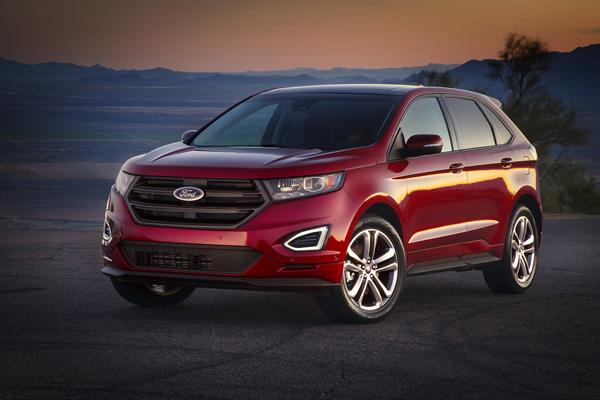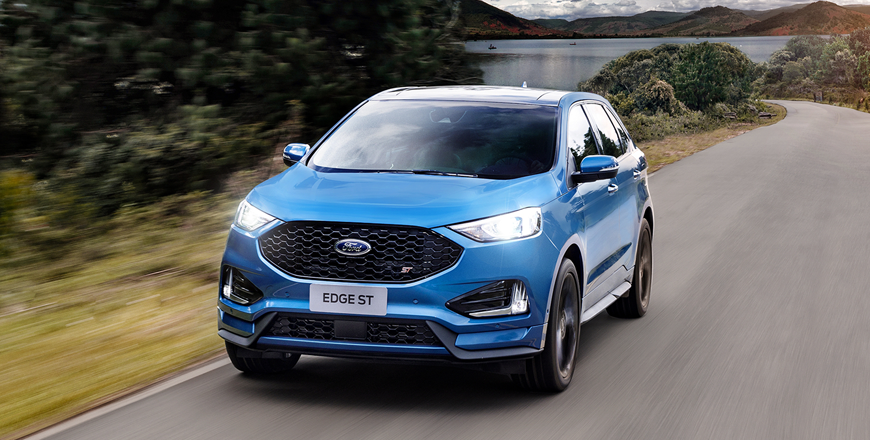You are here
Ford Edge 2.0 Ecoboost – Titanium AWD: Edging ahead
By Ghaith Madadha - Nov 21,2016 - Last updated at Nov 21,2016

Photo courtesy of Ford
First launched in late 2006, the Ford Edge was the Blue Oval’s first foray into a then still somewhat nascent car-based compact SUV segment that soon developed into the now booming Crossover or CUV segment. Replacing the long-serving original, the new Edge first launched in the US as a 2015 model and arrived in the Middle East and global markets earlier this year. Slightly larger, better packaged and with a more focused European flavoured dynamic experience, the new Edge is a huge all-round improvement on its predecessor.
Built on Ford’s contemporary CD4 platform underpinning many saloons, crossovers and MPVs, the Edge is perhaps most closely related to Ford’s somewhat sporty European S-Max model. More of a mid-size CUV by European standards rather than a compact model, the Edge’s ground clearance and design clearly mark it out as a Crossover SUV. However, its relation to the S-Max only becomes obvious when seated in the rear seats, where the Edge offers better passenger space and ergonomics than typical in its segment.
Ridged and rugged
Chunky and tightly packaged in terms of design, the new Edge’s fascia features a new two-slat hexagonal grille design with automatic opening and closing shutters to allow for better aerodynamics and enhanced efficiency or improved cooling when needed. Squinting headlights flank the grille and are topped with a ridged clamshell bonnet, which smoothly trails off to the roofline. From side view, the Edge features defined character lines and at the rear a tailgate spoiler and diamond-shaped lights connected by a central strip.
Sitting high off the ground and with lower black cladding and skid-plate style lower lip, the Edge has a rugged sense of charisma and the clearance for off-road driving over rutted and gravelly dirt roads and trails and dusty, sandy and choppy plains, as driven at Wadi Rum during its regional debut event. Additionally, a slightly longer wheelbase short overhangs and provides added driving stability and improved cabin dimensions to comfortably seat even larger rear passengers with generous 1,023mm leg and 1,030mm headroom.
Perky performer
Powered by a twin-scroll turbocharged direct injection 2-litre four-cylinder Ecoboost engine almost identical to that driving the thuggishly good Ford Focus ST hot hatch, the Edge 2.0 Ecoboost develops 249BHP at 5,500rpm and
278lb/ft as quoted for Middle East markets. Though it may not pack quite the same brutal wallop as used in the Focus ST, the larger and heavier 1,849kg Edge’s 2.0 Ecoboost is nevertheless perky and punchy. Driven through a slick and quick shifting automated dual clutch gearbox, it is estimated to dash through the 0-100km/h benchmark in 8- to 8.5 seconds.
Responsive and eager, the Edge’s 4-pot Ecoboost engine suffers very little by way of turbo lag from idle, and with its turbo spooling up swiftly, yields and rich and creamily abundant mid-range sweet spot. Flexible and confident in mid-range, the Edge overtakes easily and feels responsive when powering out of corners through switchbacks. Building power with a punchy urgency slightly masked by its weight and refinement, the Edge 2.0 Ecoboost has an eager and willing character, and is quoted as returning reserved 10.2l/100km combined fuel efficiency for Middle East market models.
Control and comfort
Built on a stiffer structure than before, the new Edge’s enhanced rigidity helps make it safer and a more comfortable and better handling vehicle. With MacPherson struts in front, the new Edge receives integral-link rear suspension, which allows for a rigid lateral set-up along with supple vertical movements for improved dynamics and comfort. Smooth and stable at speed, the Edge processes road imperfections comfortably despite its optional low profile 255/45R20 tyres, while rebound control is settled after crests and dips.
Finds a happy medium between comfort and handling ability the edge turns into corners tidily, with its smaller and lighter engine lending it a more agile feel for its size and weight and in comparison with V6 rivals. Quick and precise, the Edge’s steering is reassuringly stable at speed, but feels responsive and positive through corners. Well controlling body lean for a vehicle this tall and heavy, the Edge’s longer wheelbase, meanwhile, lends itself to good stability and grip through long fast sweeping corners.
Generous space and equipment
Driving the front wheel primarily, the edge’s four-wheel drive system reallocates power rearwards through and electronically controlled clutch, when necessary for additional traction or grip, through corners, over loose surfaces and in off-road driving. Meanwhile inside, the Edge’s well adjustable seats and steering provide a supportive, comfortable and alert driving position. Ergonomic, user friendly and practical, the Edge features good front visibility to manoeuvre, lots of storage compartments, reclining rear seats, rear armrest, big door apertures for easy access and a low loading height for its generous 1111-litre boot.
Thoroughly well-equipped with a slew of standard and optional convenience, infotainment, safety and driver assistance systems, the driven top-spec Titanium model features 10-way adjustable heated and cooled leather seats, hands-free automatic liftgate, 12-speaker Sony audio system and voice-activated Sync infotainment system with 8-inch LCD touchscreen. Also standard is torque vectoring, dual-zone climate control, rearview camera and glovebox integrated knee, height adjustable shoulder and other airbags including. Optional equipment includes inflatable rear seats, panoramic roof, remote stop/start, blind spot and cross traffic assistance and adaptive cruise control among numerous options.
TECHNICAL SPECIFICATIONS
Engine: 2.0-litre, turbocharged, transverse 4 cylinders
Bore x stroke: 87.5 x 83.1mm
Compression ratio: 9.7:1
Valve-train: 16-valve, DOHC, variable valve timing, direct injection
Gearbox: 6-speed automated dual-clutch, four-wheel drive
Power, BHP (PS) [kW]: 249 (253) [186] @5500rpm
Specific power: 124.5BHP/litre
Power-to-weight: 134.6BHP/tonne
Torque, lb/ft (Nm): 278 (378) @2500rpm
Specific torque: 189.6Nm/litre
Torque-to-weight: 204.4Nm/tonne
0-100km/h: 8-8.5 seconds (estimate)
Fuel consumption, city/highway/combined (US EPA): 11.76-/8.4/10.22 litres/100km
Length: 4,779mm
Width: 1,928mm
Height: 1,742mm
Wheelbase: 2,849mm
Track, F/R: 1,646/1,643mm
Headroom, F/R: 1,020/1,023mm
Legroom, F/R: 1,081/1,030mm
Shoulder room, F/R: 1,531/1,536mm
Hip room, F/R: 1,420/1,461mm
Liftover height: 755mm
Luggage volume, behind 2nd/1st row, liquid, to roof: 1111-/2078 litres
Fuel capacity: 68 litres
Kerb weight: 1,849kg
Steering: Electric-assisted rack and pinion
Turning circle: 12 metres
Suspension, F/R: MacPherson strut/integral-link, coil springs, anti-roll bars
Brakes, F/R: Ventilated discs, 345mm/315mm
Tyres: 255/45R20 (optional)
Related Articles
First introduced in 2006 as the fashion for crossover SUVs was starting to gather momentum as a chunky and assertive compact to mid-size fam
Edging out the superb Ford Focus ST hot hatch as the iconic American manufacturer’s most compact performance vehicle in its home marke
Winner of the 2015 Middle East Car of the Year Award, the latest generation of Ford’s attainable icon, the new Mustang is the most advanced,














